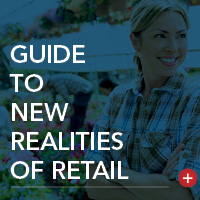 Social media is a marketer's best friend, but creating a brand presence on social media also can be pretty daunting. With a recent study from Deloitte reporting that 47 percent of millennials are influenced by social media when making a purchase decision and 19 percent of non-millennials are influenced by social media during a purchase process, ignoring this valuable marketing avenue is not the right approach for any retailer.
Social media is a marketer's best friend, but creating a brand presence on social media also can be pretty daunting. With a recent study from Deloitte reporting that 47 percent of millennials are influenced by social media when making a purchase decision and 19 percent of non-millennials are influenced by social media during a purchase process, ignoring this valuable marketing avenue is not the right approach for any retailer.
Facebook, YouTube, Instagram and Twitter each can add value to your brand, help attract and retain quality customers and build a compelling online presence that mirrors the unique personality of your one-of-a-kind retail store.
Facebook
Unless your brand caters solely to a Generation Z-and-younger audience, Facebook marketing is a necessity. After all, you can't have a social media marketing strategy without a presence on the largest social media network in the world. In comparison to other social networks, however, marketing on Facebook is relatively low maintenance. Since Facebook posts stick around on your timeline, you don't have to worry about scheduling your posts exactly when your target audience is online, something other social platforms demand.
YouTube
Video content is the future of marketing for businesses small and large, helping to make YouTube one of the most important social media avenues for retailers to focus their energy. In fact, according to HubSpot, 48 percent of marketers intend to add YouTube to their content strategy in the next year. Are you among them? Through video, retailers can offer product knowledge insight, provide store tours and share updates on best-selling items, new deliveries and much more.
Before you get intimidated, however, with being on camera or having to add one more thing to your to-do-list, know that customers prefer videos that are 30 seconds or less with a maximum video time of two minutes. Posting frequent videos on YouTube is a great way for you to introduce yourself, your store and the products you sell to your video-consuming audience without having to invest too much time, effort or dollars. If video still isn't for you, consider how one of your employees may excel in helping you with your video efforts — especially when you factor in that using smartphones to film can be as easy as 1,2,3.
Instagram
Think of your company's Instagram as a digital storefront. On Instagram, you're selling your brand's lifestyle just as much as you're selling the products. The scenery in your photos should reflect the collective vibe you want your store to portray — whether this includes models highlighting the product you sell or beautiful nature scenes that align with your store's nature-inspired inventory. To help determine the lifestyle you should be marketing with your brand's social media presence, you'll need to go beyond basic consumer data. Instead, take an in-depth look at what type of imagery, activities, looks and destinations appeal to your core customer base.
As you reflect on strengthening your Instagram, remember that what works for Instagram doesn't work for Facebook or Twitter the same. It's important to consider each of these avenues as their own entity versus automating what is shared between each of them.
Twitter
Twitter has often been hailed as "the great equalizer" of social media because it provides an opportunity for individuals and companies of all sizes to start a discussion with the biggest names in business. The greatest challenge for new Twitter users is usually in trying to keep their posts under the character limit, but the opportunity to grow your brand and have a public dialogue with your customers makes Twitter far worth the initial effort.
Like any other major social media platform, Twitter users are most responsive to posts when they're accompanied by high-quality imagery or strong content — or both. This does not mean you need to uniquely create the images or content, however. On Twitter, sharing others content or posting an article from a favorite lifestyle website that aligns with your consumer audience is among the best ways to grow and keep your Twitter followers. To further increase your Twitter engagement, be sure to communicate with others via Twitter and encourage conversation among your followers, as well. Ask questions, answer questions and make sure to check daily. Twitter is a destination for customers to turn to when they have questions and want them answered fast.
Social Media 101 for Retailers
Social media is part of the omnichannel journey consumers make when navigating purchase decisions, therefore it's critical for retailers to have a clear avenue to a point of purchase from each social media site they visit. This should include a visible URL link to your main website as well as hyperlinks to landing pages that lead customers to make purchases — even if you don't sell anything online. Directing customers to a contact page that includes your store address and contact details is also a valuable place to direct consumers to a purchase. Additionally, make sure your branding is consistent across each social media platform in order to strengthen your entire brand experience.
Find more ideas to strengthen your customer relationship in CNA's 2018 Guide to the New Realities of Small Retail.

From the Author
Nicole Leinbach Reyhle is the Founder and Publisher of RetailMinded.com, an industry publication that has been recognized worldwide for its leading retail insight. With a core concentration on independent retailers and small businesses, Reyhle is a frequent guest and contributor to various media outlets that include The Today Show, Forbes and countless B2B publications. Additionally, Reyhle has been the spokesperson for American Express's Small Business Saturday since 2014 and is the author of the book Retail 101: The Guide to Managing and Marketing Your Retail Business from McGraw-Hill. Reyhle writes regularly as a retail thought leader for various industry resources that include Entrepreuner.com, Fiverr.com, Forbes, IBM and more, as well as having taught Retail Management at Columbia College for eight years as part of their adjunct faculty. Reyhle is also the Co-Founder of the Independent Retailer Conference. Learn more about Reyhle at RetailMinded.com.
Disclaimer
The purpose of this Guide is to provide information, rather than advice or opinion. It is accurate to the best of the author's knowledge as of the date of publication. Accordingly, this Guide should not be viewed as a substitute for the guidance and recommendations of a retained professional. Any references to non-CNA websites are provided solely for convenience, and CNA disclaims any responsibility with respect to such websites.
To the extent this Guide contains any examples, please note that they are for illustrative purposes only and any similarity to actual individuals, entities, places or situations is unintentional and purely coincidental. In addition, any examples are not intended to establish any standards of care, to serve as legal advice appropriate for any particular factual situations, or to provide an acknowledgement that any given factual situation is covered under any CNA insurance policy. Please remember that only the relevant insurance policy can provide the actual terms, coverages, amounts, conditions and exclusions for an insured. All CNA products and services may not be available in all states and may be subject to change without notice.
"CNA" is a registered trademark of CNA Financial Corporation. Certain CNA Financial Corporation subsidiaries use the "CNA" trademark in connection with insurance underwriting and claims activities. Copyright © 2017 CNA. All rights reserved.